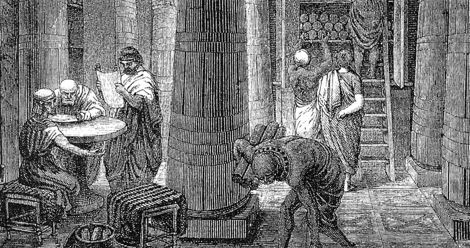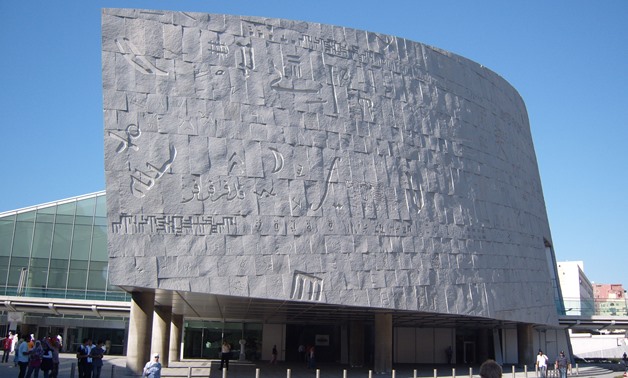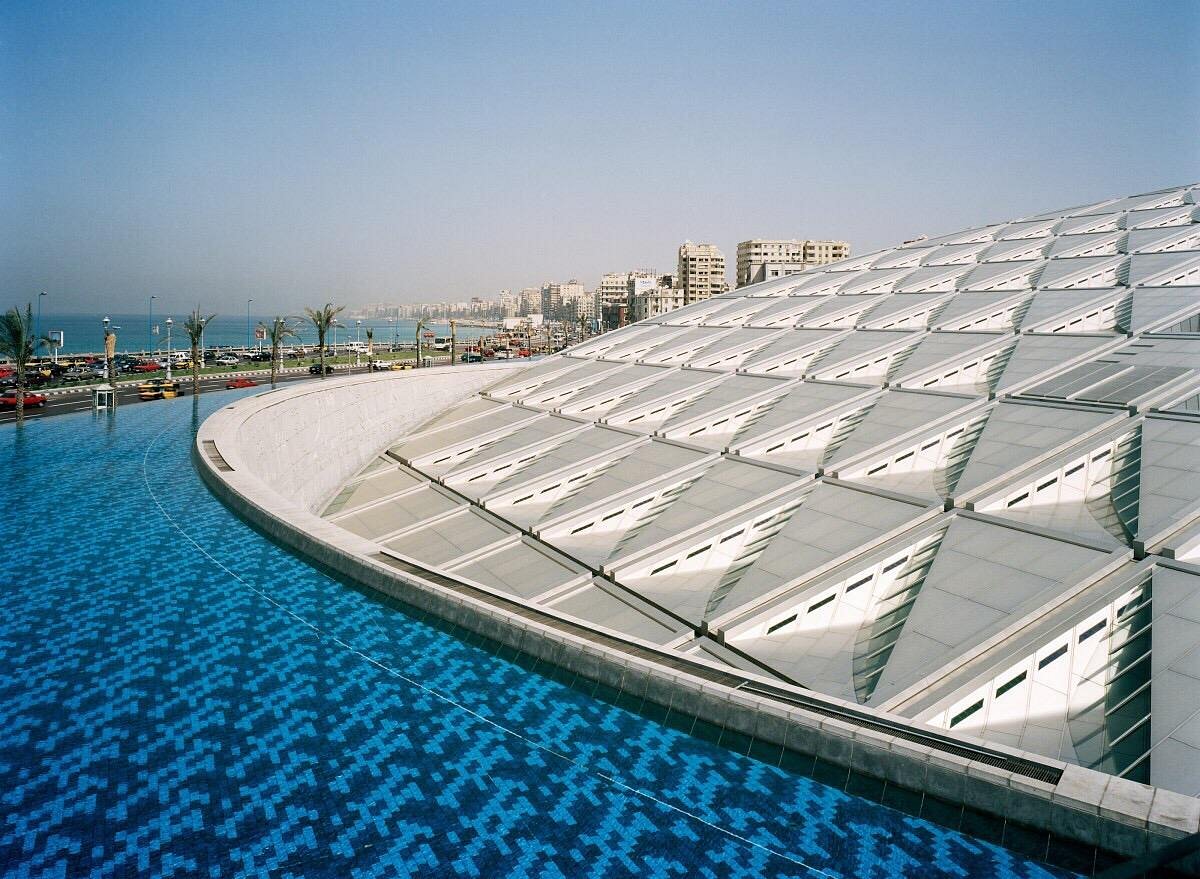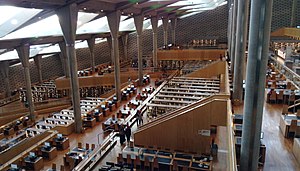The Bibliotheca Alexandrina: A New Renaissance for Knowledge
The Bibliotheca Alexandrina, also known as the Library of Alexandria, is a modern-day library and cultural centre in Alexandria, Egypt. Built to commemorate the once-great ancient library, the Bibliotheca Alexandrina is a centre of knowledge, education, and culture in the Mediterranean region.
With over eight million books, it houses specialized libraries, permanent and temporary exhibitions, and a restoration centre. The library's architecture is equally impressive, with a stunning main reading room under a 32-meter-high tilted panelled dome that overlooks the Mediterranean Sea.
This post will explore the rich history and significance of the Bibliotheca Alexandrina and how it aims to usher in a new renaissance for knowledge in the 21st century.

Brief History of the Ancient Library of Alexandria
The ancient Library of Alexandria is a remarkable historical site from the third century BC. Located in Alexandria, Egypt, the Library was founded by Ptolemy I Soter and formed part of a more extensive research institute called the Mouseion. The Athenian statesman living in Alexandria proposed the concept of a universal library. Although plans for the Library were initially established then, it is believed that Ptolemy II Philadelphus built it during his reign.
The Library of Alexandria quickly gained fame and recognition for its massive collection of scrolls, which grew exponentially thanks to the Ptolemaic king's aggressive and well-funded policies for procuring texts. There are estimated to have been between 40,000 to 400,000 scrolls housed in the Library of Alexandria at its peak, making it one of the world's most extensive libraries.
Alexandria soon became known as the capital of knowledge and learning, and much of its prestige was attributed to the wide selection of texts available in the Library and the influential scholars who worked there. Unfortunately, despite its initial success, the Library gradually declined over several centuries due to a lack of funding and support. This decline eventually led to the destruction of the once-great Library of Alexandria. [1][2]

Purpose of the new Bibliotheca Alexandrina
The purpose of the new Bibliotheca Alexandrina is to revive the ancient library and establish a new intellectual and cultural centre in Alexandria, Egypt. The idea of recreating the old library dates back to 1974, and various individuals and organizations, including Egyptian politicians and UNESCO, adopted it.
The construction of the new library started in 1995, and after spending around $220 million, the complex was officially inaugurated on October 16, 2002. The project's purpose was to play a vital educational, cultural, and scientific role throughout the region, and indeed, it has achieved its goal comprehensively.
The new Bibliotheca Alexandrina is a trilingual library containing Arabic, English, and French books. It has eight million books, and the main reading room covers 20,000 square meters (220,000 sq ft) on eleven cascading levels. The library has specialized collections for maps, multimedia, the blind and visually impaired, young people, and children. Besides, it has four art galleries for temporary exhibitions and 15 permanent exhibitions showcasing different aspects of knowledge, art, and culture.
The library's architecture is a wonder in itself, with the main reading room standing beneath a 32-meter-high tilted roof panelled with grey granite and measuring 160 meters in diameter. The walls are adorned with carvings from 120 different scripts and alphabets. The complex also houses a planetarium and a restoration room, making it a complete hub of knowledge and cultural activities.
The new Bibliotheca Alexandrina is a modern library and a cultural and scientific centre, which has once again brought Alexandria back to the forefront of intellectual and cultural thought. The story of the new Bibliotheca Alexandrina is reviving the ancient library by establishing a new institution with state-of-the-art facilities and modern architectural design. The Bibliotheca Alexandrina is a testimony to promoting knowledge and education, a new Renaissance for Knowledge. [3][4]

Date when construction started
Construction of the Bibliotheca Alexandrina started in 1995, nearly 20 years after the idea of reviving the ancient library was first proposed. In 1974, a committee selected a plot of land between the campus and the seafront for the new library, close to where the ancient library once stood. The recreation of the ancient library garnered support from individuals, agencies, and Egyptian politicians. Former President Hosni Mubarak was a leading supporter of the project, and he embraced the concept of endowing the Mediterranean region with a centre of cultural and scientific excellence.
UNESCO's involvement in the project created a great opportunity to make it truly international in focus. UNESCO organized an international architectural competition in 1988 to choose a design worthy of the site and its heritage, which was won by an architectural team of ten members representing six countries. UNESCO also created an International Commission for the Bibliotheca Alexandrina with high-level representatives from 18 diverse countries and organizations.
After construction started in 1995, over US$220 million was spent on the project. The complex was officially inaugurated on 16 October 2002. The library has shelf space for eight million books, and the main reading room covers 20,000 square meters on eleven cascading levels. The complex also houses specialized libraries for maps, multimedia, the blind and visually impaired, young people, and children. Additionally, it has four museums for temporary exhibitions, 15 permanent exhibitions, a planetarium, and a restoration room. With its stunning architecture and advanced facilities, the Bibliotheca Alexandrina brings new life to Alexandria and Egypt's intellectual and cultural heritage, promoting knowledge and education for generations to come. [5][6]

Amount of money spent on the project
The construction of Bibliotheca Alexandrina was a massive project that required a considerable amount of investment. The idea of reviving the ancient library was proposed in 1974, and the project was officially inaugurated on October 16, 2002.
An estimated $220 million was spent to construct the modern library complex, which seems justifiable considering the wide variety of collections and advanced facilities available for people of all ages and interests. The library has shelf space for eight million books, and the main reading room alone is spread across an area of 20,000 square meters (220,000 sq ft) on eleven cascading levels.
The main reading room is a true architectural marvel as it stands beneath a 32-meter-high panelled tilted out toward the sea, measuring 160 meters in diameter. The library complex also houses specialized libraries for maps, multimedia, the blind and visually impaired, young people, and children, making it an ideal destination for people of all abilities.
The collection of books was donated from all over the world, including the donation of 500,000 books from the National Library of France (BnF) in 2010, making the Bibliotheca Alexandrina the largest depository of French books in the Middle East and North Africa.
The investment made in this project represents the importance of promoting knowledge and education in today's world. [7][8]
The architecture of the library
The Bibliotheca Alexandrina is a grand structure that serves as a cultural centre for Alexandria, Egypt, and beyond. Its architecture is stunning and impactful, with a circular design that symbolizes the cyclical nature of knowledge throughout time. The building's glistening, tilting roof recalls the ancient Alexandrian lighthouse. The circular shape of the building reflects the basic continuity of mankind, and the cylindrical masonry form emerges from the earth like the rebirth of an earlier form.
This innovative library facility spans 160 meters in diameter and reaches up to 32 meters in height while diving some 12 meters into the ground. The library is constructed on a magnificent site alongside Alexandria's ancient harbour in the city's historic centre. The library not only provides shelf space for eight million books (with the possibility of expanding to cater to even more), but it also contains other cultural and educational functions, including a planetarium, several museums, a school for information science, and conservation facilities.
The main reading room is the world's largest open reading room, with shelf space for 2000 readers covering 20000 square meters on seven terraces. The reading room's design reduces book retrieval time considerably, with the reading areas and stacks arranged closely together at the same level to ensure optimum use of space. In addition, the stacks are placed at each terrace level, underneath the next higher terrace, to maximize the exposure to natural light and the grand views of the space enjoyed by those sitting at the terrace edge.
Overall, the Bibliotheca Alexandrina is a triumph in architecture, representing a new renaissance in knowledge and a new symbol for learning and culture in the Mediterranean region and beyond. [9][10]

Shelf space for books
The Bibliotheca Alexandrina is a symbol of cultural revival and a vast repository of knowledge, containing shelf space for eight million books. The library has assembled collections worldwide, including contributions from Spain, France and Egypt, making it the sixth-largest library globally. The National Library of France donated a staggering 500,000 books, which made the Bibliotheca Alexandrina the world's largest depository of French books in the Middle East and North Africa.
The main reading room is a remarkable and beautiful space, covering 20,000 square meters on eleven cascading levels. The design is unique, and the vast circular shape is topped by an unusual panelled roof that tilts out toward the sea, reminiscent of Alexandria's ancient lighthouse. The walls are made of beautifully carved grey marble, featuring inscriptions in several languages that add to the room's grandeur and historicity.
To maximize accessibility and user-friendliness, the stacks in the library are artistically arranged horizontally across each terrace level, conveniently situated near their respective reading areas. This innovative design drastically reduces retrieval time, enabling users to browse and locate books easily. The generously spaced reading areas, surrounded by remarkable floor-to-ceiling windows, provide natural light and offer breathtaking scenic views of the Mediterranean Sea. This stunningly designed environment inspires and stimulates readers and researchers alike. Additionally, the shelves are thoughtfully engineered to accommodate books of different sizes, allowing adequate space for all volumes.
Over the years, the collection has been meticulously organized and repeatedly refined, ultimately transforming the library into a venerated beacon of knowledge. Enriched with multilingual catalogues and online resources, the library is a primary choice for students, researchers, and the public seeking unparalleled services. Visited by individuals worldwide, this library provides boundless resources and knowledge for all. [11][12]

Reading room size
The Bibliotheca Alexandrina boasts one of the largest reading rooms worldwide, covering 20,000 square meters or 220,000 square feet. This reading room is situated on eleven cascading levels and can accommodate many library-going individuals. The main reading hall is located beneath a massive, 32-meter-high tilted glass panel facing the sea, creating a surreal ambience for readers – a refreshing change from drab library settings.
The library's architecture is unique, with grey granite floors, walls carved with inscriptions from 120 scripts, and striking poses of ancient gods. The reading room's natural light source is innovative in that it filters sunlight through translucent layers of material created to modulate different degrees of brightness. This creates a serene and comfortable reading environment for everyone, which is crucial for a successful library experience.
The Bibliotheca Alexandrina's design philosophy is to blend ancient and modern architectural concepts, evident in every part of the library, from the sleek walls to the intricacies of the ceiling design. The primary idea behind the library's architecture was to make an attractive building that would draw people to read and learn. This innovative architectural style has worked well since the library attracts millions of visitors each year, making it a popular destination for learning and savouring beautiful architecture.
What's remarkable about the library's reading room is its size. It's the perfect space for professionals, students, and researchers to sit and work with resources at their fingertips. The library's comfortable seating areas and innovative lighting design make it an enjoyable and relaxing place to read and learn. The reading room is also a space for studying and reflection, with beautiful views of the surrounding area, making it a vital destination in Alexandria for research and education. [13][14]

Specialized libraries
Specialized libraries are one of the fascinating features of the Bibliotheca Alexandrina. The library is not just a repository of books but a resource centre that aims to cater to the diverse interests and needs of its patrons. The specialized libraries offer a distinct collection of books, multimedia, and other resources catering to specific subjects and audiences. Here are some noteworthy specialized libraries at the Bibliotheca Alexandrina:
1. The Maps Library: A treasure trove for cartography enthusiasts, this library contains many maps and atlases from different periods of history and cultures. The library also showcases globes, 3D maps, and other related resources.
2. The Multimedia Library: With a focus on audio-visual resources, this library has an impressive collection of videotapes, audiotapes, CDs, and DVDs covering a wide spectrum of subjects from education to politics, culture, and religion. The library also features a showroom and study rooms with the latest audiovisual equipment.
3. The Blind and Visually Impaired Library: This specialized library is designed to cater to the needs of the visually impaired community. It has an extensive collection of Braille books, audiobooks, and other resources that enable the visually impaired to access information and knowledge easily.
4. The Young People's (YP) Library: Young adults aged 12 to 16 are the target audience for this library. The collection of books in the YP area covers various subjects considering young adults' reading levels, needs, and requirements. The collection also includes multimedia and e-resources with free access to the Student Resource Center (SRC) database, covering most subject areas.
5. The Children's (CH) Library: This library is designed for children aged 6 to 11, providing a wealth of resources and programs to develop children's reading, research, and creativity skills. The collection includes picture books, easy-to-read books, reference materials, and multimedia materials covering various subjects in many languages. The interactive computer lab in the library allows children to explore exciting websites and learn how to conduct library research.
The Bibliotheca Alexandrina's specialized libraries showcase how knowledge and education can be accessible and engaging for people of all ages and backgrounds. These libraries also reflect the library's commitment to promoting lifelong learning and fostering a culture of intellectual curiosity. [15][16]

Exhibition halls
The Bibliotheca Alexandrina is not just a library, it's also home to many specialized libraries, laboratories, restoration rooms, and exhibition halls. The library aims to promote knowledge and education through various means, and one of these is by hosting exhibitions. The library has four exhibition halls dedicated to both permanent and temporary exhibitions. These halls allow visitors to explore different themes and topics related to diverse fields.
The exhibitions hosted at these halls cover various topics, from ancient history to modern science and technology. Some of the temporary exhibitions have included photography, art, and archaeology. While the permanent exhibitions are focused on the history and culture of Egypt, including the Pharaonic, Ptolemaic, and Greco-Roman periods. Visitors can learn about the contributions of ancient Egyptians to the world, such as their knowledge in medicine and astronomy.
One of the recent exhibitions hosted in the Bibliotheca Alexandrina is the Wall of Knowledge exhibition. This exhibition features The Book of the Dead: The Papyrus of Ani, one of the most interesting stories of Ancient Egyptian civilization. Through the Wall of Knowledge project, the library developed an augmented reality (AR) mobile application that allows visitors to interact with the Book of the Dead in different languages, English, Arabic, and French.
The exhibition halls in Bibliotheca Alexandrina allow visitors to explore new areas of knowledge and expand their understanding of different fields. The library aims to provide visitors a cultural and scientific experience, and the exhibition halls are just one of the ways it does so. With the new age of technology, the library has found ways to showcase its collections and exhibits in many creative ways. [17][18]

Laboratories and restoration rooms
The Bibliotheca Alexandrina is not just a public library; it also boasts several specialized facilities that make it truly unique. Among these is a laboratory and restoration room, set up as part of the mission to preserve valuable books and documents throughout history. Placing this facility within the library complex is a testament to the commitment of its creators and the government of Egypt to protect the world's cultural heritage.
The laboratory is staffed with highly trained experts who are adept in the latest techniques for restoring and preserving books and archival materials. They have the knowledge and technology to deal with various issues facing delicate artefacts. The laboratory offers services to individuals with family heirlooms and institutional collections.
With millions of books housed within the Bibliotheca Alexandrina's walls, some will inevitably require restoration during their lifetime. This is where the restoration room comes into play. The room is specifically designed with state-of-the-art tools needed for the delicate task of repairing and restoring books. Experts carefully repair and restore valuable manuscripts, maps, newspapers, and other objects kept on the Bibliotheca's shelves.
The laboratory and restoration rooms within the Bibliotheca Alexandrina stand as a testament to the facility's dedication to preserving cultural history while promoting knowledge and education. Their presence emphasizes that in the modern era, it is essential to seek out the knowledge of the past and protect it for future generations. [19][20]

Final thoughts on the importance of promoting knowledge and education.
The Bibliotheca Alexandrina is not just a mere building but a symbol of knowledge, culture, and progress. Its main mission is to promote the development of an independent, self-confident, and literate citizenry by providing open access to cultural, intellectual, and informational resources of all types. It is a centre of knowledge and learning that aims to educate and inspire people of all backgrounds to pursue their passions and interests.
The library's Collection Development Policy guides library personnel, academics, professionals, and the public in making decisions regarding the selection, management, and preservation of its materials. Its purpose is to support the library's wide range of teaching, learning, and research goals and to promote the continuity and consistency of collection development over time.
The Bibliotheca Alexandrina's dedication to promoting knowledge and education is evident through its extensive collection of print, audiovisual, microform, electronic, and web resources that are made accessible to all library users. The library's commitment to providing open access to information is essential to the ongoing process of maximizing the acquisition budget while at the same time increasing the availability of resources to the library's patrons.
The new Bibliotheca Alexandrina is an instrument for rising to the challenges of the digital age, a centre for dialogue between peoples and civilizations, and a worthy successor to the great ancient library of Alexandria. It is a testament to the human intellect and imagination and remains etched in the memories of all scientists and intellectuals. It is a beacon of hope and inspiration, promoting knowledge and education as the key to progressing towards a better future for all. [21][22]
